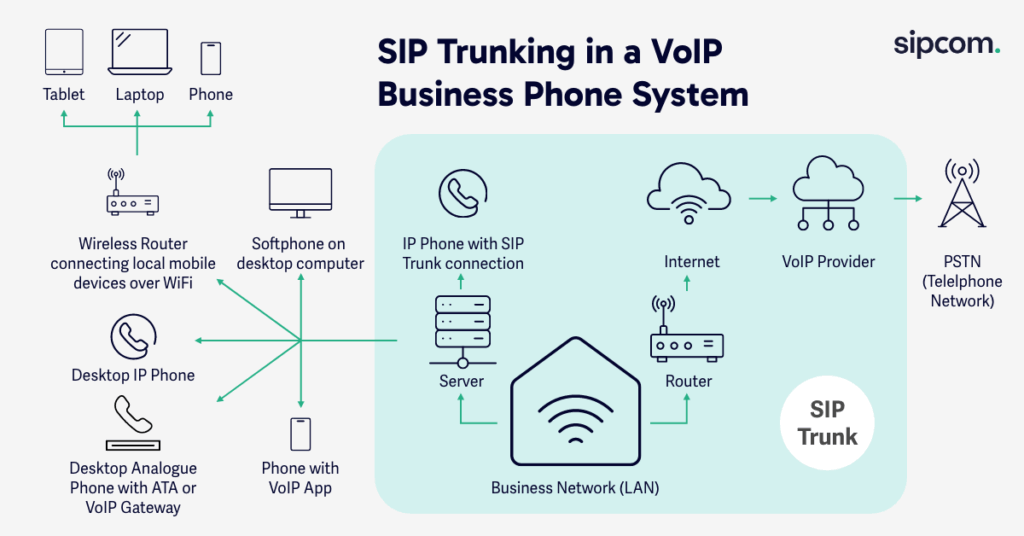From remote work to global collaboration, the way organizations communicate has transformed in just a few years. Modern businesses face the challenge of building communication systems that are as agile as the world around them. They now demand much more from their communication platforms.
This desire to scale at their own pace and communicate in a unified way is driving organizations away from legacy phone systems, which are unable to keep up with the new demands. For many, a system built on SIP (Session Initiation Protocol) trunking is now the answer.
This blog is your key to understanding SIP trunks, what the benefits of SIP trunking are, and how you can pick the right provider for your own project.
Why SIP trunking?
SIP trunking stops businesses from being tied down by traditional phone lines. It connects their Private Branch Exchange (PBX), which handles traditional telephony, to a SIP provider.
The SIP provider uses SIP – a signaling standard that sets up and manages communication sessions on virtual ‘trunks’ via the internet – to provide a secure, efficient, and scalable way to manage communication needs.

How does SIP trunking work?
In SIP trunking, SIP is used to make sure devices can connect, manage, and end communication sessions seamlessly.
While SIP manages the call, it integrates with other protocols like Real-Time Transport Protocol to carry voice and video data, and Session Description Protocol to define settings like encryption.
What does a SIP trunking call flow look like?
When a SIP call is placed over a SIP trunk, the PBX forwards a request to the SIP provider, which then authenticates it and links the call to its recipient via the internet.
Features like caller ID, call forwarding, and failover are available if lines are busy when the call is routed to its endpoint by the SIP provider. These features, alongside consolidated lines and automated routing, make SIP trunking highly efficient.
SIP trunking vs traditional phone lines: What are the benefits?
While traditional phone lines have long been the standard, SIP trunking offers a more modern approach – delivering cost savings, flexibility, and advanced features that can better support today’s businesses.
SIP trunking saves costs
- Lower traditional phone line fees: With calls handled over the internet, businesses no longer need to rely on costly copper phone lines and their associated rental and maintenance fees.
- Reduced costs for long-distance calls: For businesses making international calls, having their communications handled over the internet can reduce the need for the expensive connection fees associated with traditional phone lines.
SIP trunking is scalable
- Instant capacity changes: As SIP trunks are virtual, they can be seamlessly scaled up and down to fit with changing business needs, rather than requiring physical alterations as in a traditional setup.
- Technical ease: Changes to capacity can typically be handled in-house, rather than waiting for third-party engineers or on-site work.
SIP trunking is flexible
- Hybrid work support: With SIP trunking, calls run over the internet, so employees aren’t tied to the office phone system. This provides more flexibility than a traditional phone line-based setup.
- Vast device choice: Unlike legacy phone lines, SIP trunking provides device choice, meaning teams can choose between softphones, laptops, mobile apps, and more to manage calls – not just traditional desk phones.
- Location freedom: Businesses don’t need to tie their phone numbers to a specific physical line with SIP trunking. This means they can move offices, regions, or even countries without losing their existing numbers.
SIP trunking unlocks enhanced features
- Advanced call routing: SIP trunking unlocks advanced call management systems seamlessly – like department call routing, multiple device ringing, call forwarding to mobile devices, and time-based rules – all of which are delivered with greater flexibility than with traditional phone systems.
- Integration with Unified Communications (UC) tools: SIP trunks can integrate with UC tools, letting businesses manage all their communication channels through a single platform.
Now you’ve learned what it is and how it works, let’s explore how you can bring SIP trunking to your organization, starting with finding the right SIP provider.
How to choose the SIP trunking provider that’s right for you
There’s a lot to consider when choosing a SIP provider. We recommend you evaluate them on how they deliver high-quality and reliable networking, and suitable geographic coverage. Seamless integration, hands-on support, and clear adherence to SLA requirements are also must-haves, as is a solution that can be flexibly deployed to suit the needs of your business.
How to transition to SIP trunking
When you’ve decided on your provider, you’re ready to begin implementation. While all deployments will be unique, here are the three stages that are typically required.
Stage one: Planning
First, outline your requirements by considering metrics like the number of concurrent calls you need, geographic coverage, platform integrations, and redundancy requirements. Then, evaluate your current systems, noting what can be kept in place and what will have to be upgraded. Once you know where you’re heading, you can plan a step-by-step roadmap, including timelines and budgets.
Stage two: Technical requirement checks
SIP trunking requires reliable bandwidth to meet your call volume and data transfer needs, so consider whether your current internet connection can handle both. Bear in mind, it must have a properly configured network infrastructure – including routers, firewalls, and SBCs (Session Border Controllers) – so you’ll need to keep hardware and firmware up to date to ensure compatibility.
Reliable calls are essential to modern business, so to ensure there are no dropouts in your service, set up QoS policies that prioritize voice traffic over data – even during periods of heavy network usage.
Stage three: Implementation
Set up your SIP trunks on your PBX or UC platform and configure your credentials in line with the requirements of your SIP platform provider. Once in place, run pilot tests on your SIP trunk for internal and external calls and any integrations with UC platforms, making a note of quality, redundancy, and failover. A phased approach or limited deployment can help reduce the risk of unexpected issues occurring and ensure that they are dealt with before you begin wider adoption.
This may all seem like a lot to consider, but with a dedicated partner handling your SIP trunking project, these things will be taken care of for you.
With a partner like Sipcom, your SIP trunking is taken care of
Our experts can help you through the entire process, so you can move quickly to the benefits of a SIP trunking system without getting caught up in the details.
If you’d like to get started, we’re happy to help.
Contact our team today
Want to start selling SIP trunking solutions?
Whether you need to develop your SIP trunking expertise or want a dedicated partner to expand your offering, we’re ready to help you maximize the SIP trunking opportunity.
Become our partner
Frequently asked questions about SIP trunking
What is SIP trunking and how does it work?
SIP trunking is a way for businesses to move their communications from physical hardware to internet-based services. It works by connecting PBXs to a SIP provider, which uses SIP to move communications onto virtual ‘trunks’ on the internet – making it a secure, efficient, and scalable way to manage enterprise-level communications.
What’s the difference between SIP trunking and VoIP?
VoIP (Voice over Internet Protocol) is a method of delivering voice calls via the internet. SIP trunking is a way of implementing VoIP, using it to connect phone systems to the public telephone network.
What are the benefits of SIP trunking?
SIP trunking offers cost savings, flexibility, scalability, and easy access to advanced call features.
What are the benefits of SIP trunking compared to traditional phone lines?
- Costs: SIP trunking eliminates the need for phone line rentals and the associated maintenance costs that come with traditional systems.
- Flexibility: SIP trunking supports a mobile or dispersed workforce with communications able to route to different locations rather than being tied to a physical office.
- Scalability: While traditional telephony requires physical upgrades to scale with demand, SIP trunking can enable this from within online portals.
- Enhanced call features: Accessing advanced call features is easy with a SIP trunking system, whereas these upgrades may rely on physical hardware changes in a traditional system.
Can SIP trunking work with my existing phone system?
Absolutely. Through our HALO Platform, Sipcom can facilitate integration and interop with existing business systems, PBX/UC platforms and supplier relationships. This ensures that feature requirements, which may not be available natively, can be met and allows customers the option of a phased migration path with the co-existence of existing technologies during transition.
The HALO Platform offers a Bring-Your-Own-Carrier (BYOC) service which allows organizations to consume SIP-based PSTN services from multiple suppliers. BYOC offers businesses ultimate flexibility by allowing them to bring their existing carrier into our environment, meaning no more early termination charges, no need for porting, and no need to purchase new numbers.



